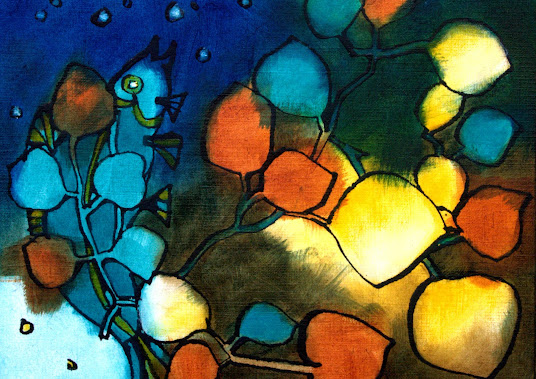After a bright start with my first painting of the year, the next two have got a little stuck. It's something to do with wanting to carry on with the feel of the horizontal paintings from last year's sketchbook, which is impossible not least because I've come out of the sketchbook onto 'better' paper. Unbeknownst to me, the first painting of the year managed this transition because actually it was a slightly different ratio to the horizontals, which meant that the image had to evolve in a slightly different way.
Insisting on the original ratio, the second one (above) was more or less able to become itself because it was no longer horizontal, so that had to change as well. But the most recent one got stuck; I drew in pencil first (rarely a good idea), I couldn't decide what forms to include, and I started out with colours I'd decided I wanted to use. All of these are known to be killers, from past experience. Here is the doomed image:
So I'm doing something now that I rarely do, which is stop to think about what I'm doing and how I'm doing it. Assessing what's evolved of its own accord, in terms of sources, noticing how the changing scale has affected the size and placement of images, and admitting to a change in process that has become safer and less unpredictable. This is exactly what made me leave the animal series a couple of years ago, despite the fact that in that case the images were still interesting to me, and they remain some of my most-loved ones in terms of card and print sales.
That's too bad. I'm not here to achieve card and print sales. My line has to be free, risking itself with ink and no pre-planning (which I was doing with the animal series, but somehow it ran its course nonetheless).
My subject matter inspiration wandered last year into 50s design, and then to woodcut motifs. I abandoned my rule about not taking shapes and forms from living artists, and just followed anything that fell into the process. The horizontal format arose accidentally and I loved it. But now it's time to move into something different.
Something that I can't see in advance, something that gives me cold sweats and fear as I hand over my conscious desire to make paintings to the ink bottle with its uncontrollable nozzle and try to trust to something much more exploratory and unknown. You probably won't notice anything different. But I will.
I'm going to give up ideas from 50s design and living artists, though I may be allowed to play with the forms that have already landed in last year's paintings. I possibly may force myself to work out my own abstractions of living forms, something that I'm usually too impatient and hasty to bother doing.
Or I may not, because frankly the need to make a painting is so strong in me that if I want to keep the spontaneity of my line and composition alive it may just be that not working out anything at all in advance may be my only possibility.
Apart from not wanting to steal from living artists, I think one of the reasons that I don't want to persist with using European woodcut forms is something to do with what I can only think to call cultural imagination. Attractive and clever as those designs and woodcuts are, our imaginations here in Europe and America have seen those forms many, many times. I began to notice this, as I got attracted again and again, that there was a certain kind of designy form that I love, but I've simply seen it too many times before. Whereas when I look at a 17th century design form from Assam, India (or an Ajanta cave paintings...), I find a whole new world.

The composition is different, the forms are different, the colours are different. The handling of space is different. My imagination doesn't know what's going on here, it has no idea what to reference to. I could read up on the fact that it's from a narrative about Krishna if I wanted, but I don't really care about that. I can't experience it as a narrative about Krishna because I wasn't brought up in India. But as this, as a visual idea, is not made up of ideas or meanings that need to be articulated in words, I can have some kind of an experience without them. Something that thrills my soul, because of its different-ness, it's unknown-ness.
So I think I may try to go back to mining the colours and forms that populate my lifelong study of the Indian aesthetic, and see if there's anything there that what wants to happen anew. In an odd kind of way, as someone who once studied Indian history, and even had a tortuous year of Sanskrit which allowed me to read just one verse of the Bhagavad Gita in its original form, there's something in me that wants to stick to a version of what I think of as working from original sources.
I'm not trying to create a visual response to the world that tries in some way to be new or original, which I think you could say is one of the cultural tropes which informs 21st Century art in Europe and America. Instead I want to honour and play with the creations of long-dead artists from somewhere other; culturally, imaginatively, whose intention was not this. These artists were not trying to impress their audiences with their originality or individual cleverness, they were in service to something else; something higher and wider and stranger (have you ever read a hymn from the Rig Veda ????) that can never be known by us in terms of words or understanding. This is the field of my exploration.
.jpg)


































